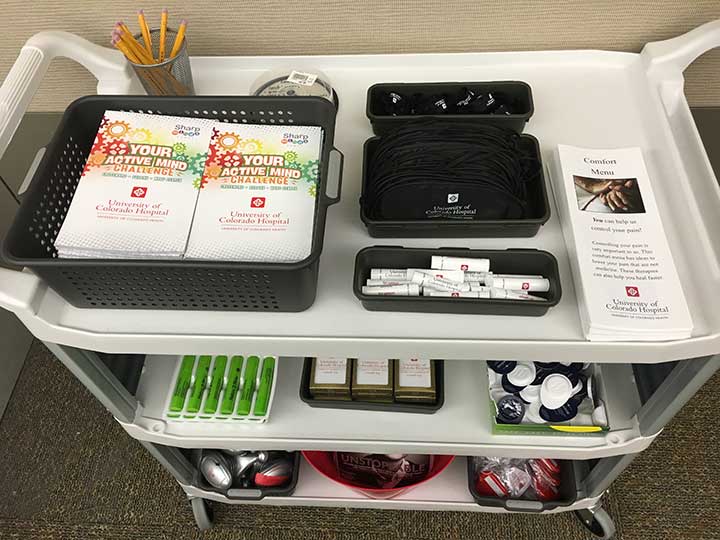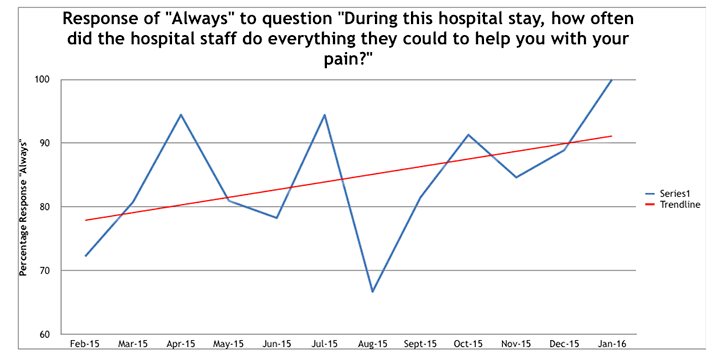One hospital’s journey to improve the patient experience.
Takeaways
- In an effort to improve the state of pain management, nurses in the acute care setting of one hospital developed a plan to supplement traditional pharmacologic treatments with nonpharmacologic interventions.
- A Comfort Menu and Comfort Cart provide patients with nonpharmacologic pain and comfort interventions.
By Ashleigh Anderson, BSN, RN, PCCN, and Amanda Swedhin, BSN, RN, CMSRN
Despite the availability of evidence-based pain-management guidelines, pain remains prevalent among hospitalized patients and is often underreported, underassessed, and under-treated. (See Efforts to address pain management.)
Unfortunately, most healthcare providers treat pain using pharmacologic methods, leaving nursing staff to find creative, nonpharmacologic comfort measures. Patients have spoken loudly, through satisfaction surveys, that they’re unhappy with the current state of pain management in hospitals. Unrelieved pain produces short- and long-term physiological and psychological consequences, it degrades patient and family quality of life, increases healthcare utilization, drives up healthcare costs, and prevents early discharge.
Recognition of the widespread inadequacy of pain management in the acute care setting has prompted corrective efforts across healthcare disciplines, including nursing. In January 2015, The Joint Commission clarified pain-management standards to incorporate nonpharmacologic approaches to complement pharmacologic strategies. The Joint Commission also emphasized the need for quality-improvement initiatives to increase patient satisfaction and positive outcomes within healthcare organizations.
In response to the Institute of Medicine’s 2011 Relieving Pain in America report, the Department of Health and Human Services convened a panel of pain experts to develop a National Pain Strategy (NPS). A key component of managing acute and chronic pain includes developing self-management programs to improve quality of life. The NPS panel suggests that it’s “important to foster skills and integrative health self-management approaches to prevent, cope with, and reduce pain” in all care settings.
Pain Champions
At the University of Colorado Hospital (UCH)—a 626-bed, quaternary care, academic medical center—the Pain Champions of Change (UCH Pain Champions) provide leadership, education, and evidence-based quality improvement (QI) pain initiatives. Using the American Pain Society (APS) Patient Outcome Questionnaire (APS-POQ-R), they identified and surveyed 150 UCH inpatients from March 2013 to March 2014 and found that 42% didn’t receive any information about pain treatment options and 65% were never encouraged by their nurse or provider to use nonpharmacologic strategies for pain management.
Based on these results and an extensive literature review on the efficacy of nonpharmacologic pain management, an inpatient charge nurse and a Pain Champion led a QI project to improve patient comfort by developing formalized nonpharmacologic pain-management options on a 36-bed medical-surgical progressive care unit (MSPCU) at UCH. The QI intervention included providing a Comfort Menu and Comfort Cart.
Comfort on the menu
The Comfort Menu lists nonpharmacologic interventions available to the patient and family, such as ice packs, heating pads, massage, music, and aromatherapy. (See The Comfort Menu.)
The Comfort Cart includes items listed on the Comfort Menu for nonpharmacologic pain management.

Product availability, though, wasn’t going to be enough to improve the patient experience. Staff involvement and understanding of nonpharmacologic pain management was required. Education provided to inpatient care staff, including RNs and certified nursing assistants (CNAs), focused on nonpharmacologic pain interventions and the importance of a comprehensive approach to pain management for improving patient outcomes.
Rising scores
We conducted pre- and postimplementation surveys to ensure nonpharmacologic approaches were being introduced to patients. And to verify that pain management was improved by this implementation, we followed Hospital Consumer Assessment of Healthcare Providers and Systems (HCAHPS) scores related to pain management. We were particularly interested in the question, “During this hospital stay, how often did the hospital staff do everything they could to help you with your pain?”
Initial patient survey results indicated that 83% of patients on the MSPCU experienced pain requiring intervention during their hospital visit and believed that nonpharmacologic methods of pain management would have been helpful. Improvement was noted regarding the percentage of patients who were offered nonpharmacologic options after introduction of the Comfort Menu and Cart. Before implementation, 27% of patients had been offered nonpharmacologic pain-management options; after implementation, 73% had been offered nonpharmacologic options.
The HCAHPS scores also showed progressive improvement in response to the question, “During this hospital stay, how often did the hospital staff do everything they could to help you with your pain?” The responses improved from 72.2% answering “Always” 3 months before implementation to 100% 8 months after. (See Looking up).These data indicate that providing nonpharmacologic options have positively affected patients’ experience of pain management in the MSPCU.
Looking up
The Hospital Consumer Assessment of Healthcare Providers and Systems scores have shown progressive improvement since implementation of the Comfort Menu and Comfort Cart.


The outcomes of this project were shared with hospital leadership, and Comfort Menus and Carts were rolled out to all inpatient units in the summer of 2016. Initially, the impact was overwhelmingly positive. The nurses loved having easily accessible nonpharmacologic comfort interventions at their disposal, patients responded positively, and HCAHPS scores improved hospital-wide. However, initial positive outcomes have not been sustained. The project has faced ongoing challenges, the greatest of which we believe is making practice change stick and getting the patient care team to make use of nonpharmacologic pain interventions a regular part of their practice. Other challenges include Comfort Cart supply shortages, budget issues, and difficulties with ongoing and new staff education. Currently, the Pain Champions are working on strategies to reinvigorate the project and develop solutions to education and budget challenges.
Changes in federal reimbursement for hospitals since passage of the Patient Protection and Affordable Care Act (PPACA) have highlighted the need to receive patient feedback and input regarding the environment of care and have reignited an urge to improve patient outcomes related to pain management. To support use of the Comfort Menu and Cart throughout the UCHealth hospital system, we planned to present a cost analysis of the products used along with data that measures patient satisfaction and pain experience. However, because of a UCHealth rebranding and significant expansion, this QI project system-wide effort has been placed on a temporary hold.
Tips for success
The success of any pain-management intervention, including a Comfort Menu or Cart, relies on several factors. First, obtain department management support to assist with staff buy-in and to remove barriers. Perform an attitudes and knowledge assessment to gauge staff perspectives and understanding of nonpharmacologic pain-management interventions and guide education. Finally, conduct a literature review to acquire the best evidence about nonpharmacologic pain-management strategies appropriate to a specific patient population as well as the items available on a Comfort Menu or Cart.
To provide intervention structure for a Comfort Menu or Cart throughout the hospital, create a primary task force or group responsible for implementing and maintaining the Menu and Cart, as well as training staff in their use. At UCH, our Volunteer Services Department is responsible for Comfort Menu and Cart dissemination, and the UCH Pain Champions provide staff education and consultation.
How did you make them feel?
Maya Angelou once said, “At the end of the day people won’t remember what you said or did, they will remember how you made them feel.” Making people feel more comfortable is exactly what we set out to do with this project. To positively effect the patient experience at UCH, we surveyed patients, identified an area of care for improvement, reviewed the literature, collaborated with hospital leadership to create a plan, offered an evidence-based intervention, and measured patient satisfaction through direct feedback and a formal survey. Because of MSPCU’s successful outcomes, this intervention was adopted throughout the UCH inpatient setting and will affect thousands of patients. We hope this QI project will continue to have a positive effect on the patient experience and that patients will continue to remember how we made them feel.
Ashleigh Anderson is a permanent charge nurse on the medical-surgical progressive care unit (MSPCU) at University of Colorado Hospital (UCHealth) in Aurora. At the time this article was written, Amanda Swedhin was MSPCU nurse educator at UCHealth.
Selected references
Clarification of the pain management standard. Joint Commission Requirement: Clarification to Standard PC.01.02.07. Jt Comm Perspect. 2014;34(11):11.
Gordon DB, Polomano RC, Pellino TA, et al. Revised American Pain Society Patient Outcome Questionnaire (APS-POQ-R) for quality improvement of pain management in hospitalized adults: Preliminary psychometric evaluation. J Pain. 2010;11(11):1172-86.
Institute of Medicine. Relieving Pain in America: A Blueprint for Transforming Prevention, Care, Education, and Research. June 29, 2011.
International Association for the Study of Pain. Pain terms: A list with definitions and notes on usage. Recommended by the IASP Subcommittee on Taxonomy. Pain. 1979;6(3):249.
McCaffery M. Nursing Practice Theories Related to Cognition, Bodily Pain, and Man-Environment Interactions. Los Angeles: UCLA Students’ Store; 1968.
NIH: The Interagency Pain Research Coordinating Committee. National pain strategy. March 18, 2016.
Pasero C, McCaffery M. Pain Assessment and Pharmacologic Management. St. Louis: Elsevier Mosby; 2010.


















2 Comments.
I recently read What works: How can we make you more comfortable? by Anderson and Swedhin in the August 2017 issue Vol.12 No.8, and felt compelled to share my excitement over what the authors have accomplished, as well as some insight that may help them achieve their future goals. Despite having hard evidence of improved outcomes in the clinical setting, implementing change can be difficult at best. With the statistics provided by the authors careful implementation and evaluation I’m appalled that the hospital did not make greater efforts to ensure success of the Comfort Cart! Not only have they improved patient comfort and HCAHPS scores, but they have also empowered their patients with autonomy in an environment that can leave patients feeling powerless.
Last year, a nurse in a south Florida hospital also implemented a comfort cart in the ED. After significant success, she was able to expand the comfort cart to multiple units including the ICU and maternal child. Just as the authors’ studies showed, patient satisfaction and comfort significantly increased as determined by surveys and HCAHPS scores; The hospital has seen the proven success and provided the necessary support to make this a lasting measure.
In my research, I’ve found many hospitals are following in the Comfort Cart footsteps and have come up with creative ways to fund their projects. An annual fundraiser was a frequent tactic, as well as applying for grant funds, but one that stood out to me was an approach involving the community. The hospital partnered with local businesses that were willing to participate. The business financially contributed to stocking the cart, the business logo was then temporarily placed on the outside of the cart, and a volunteer team of their employees wheeled the cart throughout the hospital offering comfort cart goods. The business benefited, the employees expressed a great deal of satisfaction in giving back to their community, the hospital and hospital staff benefited, and most importantly the patient benefited.
There is significant research that shows non-pharmacological, pain management adjuncts are successful, and providing those options to patients should be second nature. Hopefully, with enough persistence, perseverance, and community education patients will expect to see a comfort cart on their hospital unit, and nurses will demand it!
In summary, bravo! I love that the authors have taken on a Goliath challenge like prompting change in the clinical setting, and given their time to such a worthy cause; It’s very inspiring. I hope I was able to provide encouragement in showing that others have seen long-term success, and give ideas on creative ways to fund the carts. I wish the authors the best and hope to see future articles detailing their ultimate success.
Sincerely,
Nicole Kelly RN, CCRN
UNCW BSN Student
Wow! What a beautiful and compassionate concept. We have all in one way or another experienced this gap between Nurses(The healers), which provide all comfort before, during, and after pharmiological care is implemented, tried and tested, and plateaus. This is the science of care not extending pharmiological treatment, but covering everything between with non-traumatic treatment. It is evident to all consumers that the healing process that happens is “the everything else” care. The moment to moment mental healing requires more tools, more solutions. Theses precious Healers (nurses) didn’t just contine to walk around with their hands tied, but made manifest their scientific compassion that absolutely crosses the divide between pain and healing. Spot on. This scientific cart shows tremendeous respect for anyone and all persons connected to the healing process. It fills the gap between staff and patients providing dignity to recipients and caretakers. The Nurses’s on hand here are precious examples of scientific love practitioners! Your hearts and ears must be enormous because this disconnect has been apparent for a long time and finally someone did something about it, thank you!